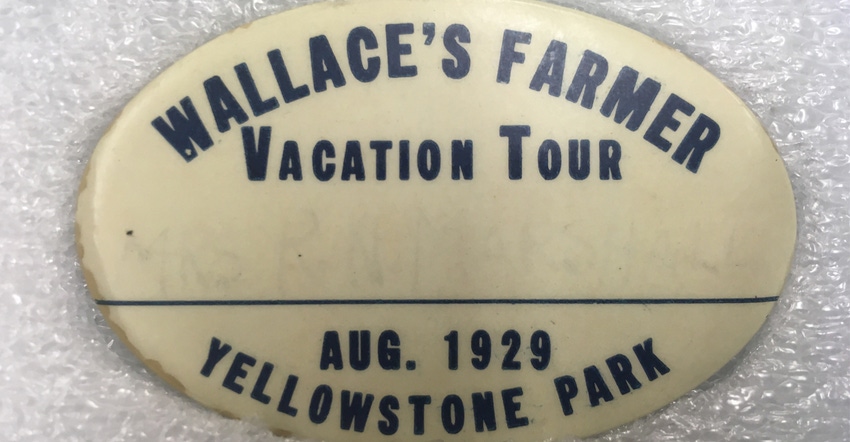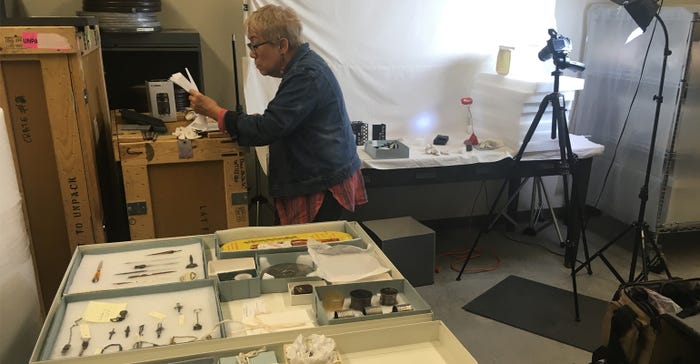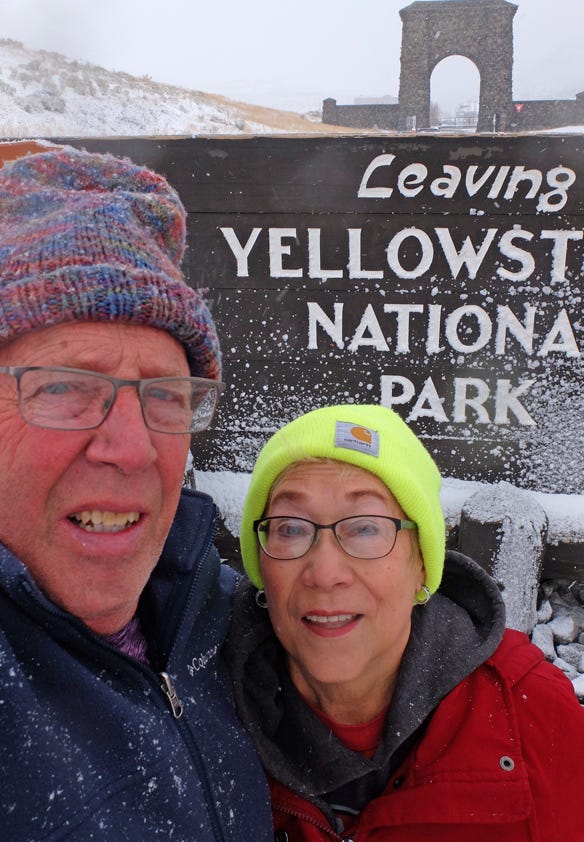December 27, 2019

Editor’s note: Wil Groves and wife Marjorie, who reside in Hamilton County, are now retired from farming, at least full time. Wil is a former field editor for Wallaces Farmer, leaving in 1974 to return to the family farm. He and Marjorie raised a family, along with crops and livestock during their long farming career. Wil was a volunteer 4-H club leader for 35 years. Honored as a Hamilton County 4-H alumni leader, he is an Iowa 4-H Hall of Fame inductee.
Yellowstone National Park houses more than 4 million artifacts, mementos, historical and archaeological objects, and biological specimens related to the park. Among them is a souvenir of a 1929 tour sponsored by Wallace’s Farmer magazine. (In those days, Wallaces had an apostrophe.)
No one knows how it came to be there. Often, such items are found and donated by family members cleaning out gramma’s attic or by the owners themselves. The park may receive an item with a note saying something like: “We thought you’d be interested in this photo album of our trip to Yellowstone in 1958.” A committee decides whether the item is worthy of inclusion in the park’s repository.
I discovered the Wallace’s Farmer souvenir while Marjorie and I worked as volunteers at the park’s Heritage and Research Center last October. The HRC, with 17,000 square feet of storage space, is just outside the Roosevelt Arch, the northeast park entrance in Gardiner, Mont.
Gold mine of information
This vast collection of some 20,000 library books, plus extensive archives and a museum, is available for researchers and the general public. However, it’s difficult to access. Interim registrar Chris Mather hopes the photography project we were involved with will remedy that problem. He says digitizing the photos and making them available online will be a boon to researchers and the public.
However, it’s not a project done quickly or easily. We’ve worked on it (as have many other volunteers and staff) each of the five times we’ve volunteered at Yellowstone. In earlier visits, we photographed most of the insect, bird and animal specimens in the collection.

REMEDY: An ongoing photography project will make Yellowstone Park’s vast collection of artifacts, memorabilia, and plant, animal and insect specimens available online to researchers and the general public.

We’ve photographed artifacts, park souvenirs, memorabilia and archaeological finds. These finds included ancient arrowheads, 1950s beer cans, Yellowstone Park dining room silverware and place settings, military regalia, Native American jewelry, and historic photos such as President and Mrs. Coolidge feeding a park bear.
We have photographed pins, buttons, bracelets, makeup kits, knives, gloves, hats, tie clasps, money clips, wallets, playing cards, post cards, dolls, toys, games, and sewing kits adorned with images of Old Faithful and grizzly bears, to name a few of the iconic Yellowstone images found on these items.
Button brought back memories
The Wallace’s Farmer tour button was nestled somewhere amid this ephemera. It caught my attention because of the Iowa connection and the fact I had worked for the magazine in the early 1970s. The button was on a tray with a dozen or so other objects stored somewhere deep in a back-room cabinet.
 GIVING BACK: Wil and Marjorie Groves have volunteered five times at Yellowstone National Park the past few years, helping sort, organize and photograph items in its museum collection.
GIVING BACK: Wil and Marjorie Groves have volunteered five times at Yellowstone National Park the past few years, helping sort, organize and photograph items in its museum collection.

Each item had an attached identification number, which was noted on the accompanying inventory sheet. We took at least three photos of each item: an overall view with the item number for reference and a small ruler to indicate size. Then, we did close-ups to show fine details, such as engraving or scrollwork. After trays were completed and inventoried, they went back into storage. On a good day, we could photograph 100 or so objects.
The process continues with the next set of volunteers. If all goes well, you may be able to go online in a couple of years and access that 1929 Wallace’s Farmer farm tour souvenir button. And you’ll know who took that photo.
And now, the rest of the story
By Rod Swoboda
In November, Wil Groves sent me an email message with a photo attached, showing a pin-on-your-shirt button that says, “Wallace’s Farmer Vacation Tour, Aug. 1929, Yellowstone Park.” He and wife Marjorie had spent a month volunteering at the huge national park, working at a research center in the Montana portion of the park.
Part of their job was photographing artifacts in the park’s archives and organizing them for future reference. One of the items that caught their eye was the memento of the 1929 Wallaces Farmer tour.
“I’m sending this photo to you because this button might be of interest to you and Wallaces Farmer readers,” Wil said in his email message.
In my answer I told Wil that I wasn’t aware that Wallaces Farmer was offering tours as far back as 1929. Wil said he didn’t know much about the history of the Wallaces Farmer tours, and like me was surprised they had such early roots.
“I was surprised to see the button from 1929,” Wil said. “I knew Wallaces Farmer and Farm Progress were once upon a time in the tour business and hosted a lot of tours during the 1970s when I was a member of the magazine’s staff. In fact, Marjorie and I got to go on a European tour in 1972 or 1973, as we served as tour hosts, representing Wallaces Farmer.”
The Farm Progress magazines advertised the “No-worry tours,” as they were called back then when Wil worked here and when I started in 1976, and there were only four magazines in the company in those days: Wallaces Farmer in Iowa, Illinois Prairie Farmer, Indiana Prairie Farmer and Wisconsin Agriculturist.
I remember the tours were popular among our readers, as they were agricultural tours, providing an opportunity for farmers here to travel to other countries and see, learn and appreciate what farming, agriculture and life was like in far-away places. Plus, you traveled with a group of people like yourself, interested in agriculture.
Some of my former colleagues got to go along on those tours as hosts of our magazines sponsoring the tours, as Wil and Marjorie did. I never went on a Farm Progress no-worry tour, but I did visit Yellowstone National Park a long time ago. My family farmed and raised hogs, cattle and several thousand egg-producing chickens when I was growing up. We didn’t take many vacations — not more than a day away. However, we did head out West to visit relatives once.
On the way, I remember camping at Yellowstone Park, in a tent and our family station wagon, with Mom, Dad and four of us kids on that vacation in 1964. And I remember how awesomely huge Yellowstone is, and its unique, natural, pristine beauty.
You May Also Like




